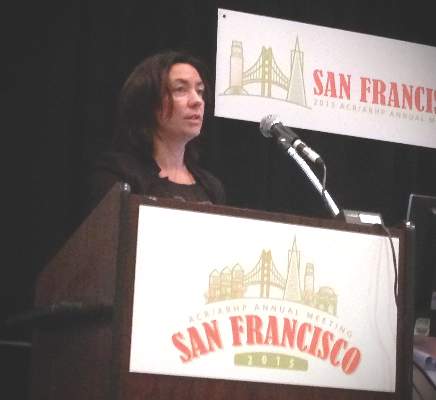User login
SAN FRANCISCO – Patients with rheumatoid arthritis were five to nine times more likely to develop lower intestinal perforation on tocilizumab, compared with conventional synthetic disease-modifying antirheumatic drugs (csDMARDs), tumor necrosis factor inhibitors, abatacept, or rituximab, according to a large observational registry study.
“The increased risk could not be explained by glucocorticoid use or the age of the patients, which was similar to other patients treated with biologics,” said Dr. Anja Strangfeld of the German Rheumatism Research Center in Berlin. The findings reinforce previous smaller analyses of clinical trial data, and also localize the risk of perforation exclusively to the lower gastrointestinal tract, she added. “Overall, the mortality with lower intestinal perforation was high, and even higher with tocilizumab,” she said. “Tocilizumab patients with lower intestinal perforation present atypically, and patients starting treatment should be advised that symptoms might be mild, but the event is severe.”
Lower intestinal perforation is fairly rare, with a population-level incidence of about .04 cases for every 1,000 person-years. The risk in patients with rheumatoid arthritis (RA) is higher – anywhere from 0.15 to 1.3 cases per 1,000 person-years, Dr. Strangfeld noted. And the reported risk for tocilizumab is higher still, approaching two cases per 1,000 person-years, according to an analysis of 18 cases reported from clinical trials.
To better evaluate that risk, Dr. Strangfeld and her colleagues analyzed observational data collected between 2001 and 2015 for 15,000 patients with RA who were included in the German biologics registry, RABBIT. Patients were followed for 5-10 years, with Disease Activity Score in 28 joints (DAS28), treatment, and adverse events tracked every 6 months. Patients had been on RA therapies for about 7-14 years; tocilizumab patients had received the monoclonal antibody for an average of 10.6 years.
Medical record reviews confirmed 36 cases of lower intestinal perforation, 11 each on tocilizumab and csDMARDs, 12 on tumor necrosis factor (TNF) inhibitors, and one each on abatacept and rituximab. Notably, the incidence rate for lower intestinal perforation on tocilizumab was three cases per 1,000 person-years, compared with 0.5-0.6 cases per 1,000 person-years for csDMARDs, abatacept, and TNF inhibitors; and 0.2 cases per 1,000 person-years for rituximab, Dr. Strangfeld said at the annual meeting of the American College of Rheumatology.
Furthermore, four of the 11 patients who developed a perforation on tocilizumab only had late-onset abdominal pain, whereas more than 90% of those on csDMARDs had early, acute abdominal pain, Dr. Strangfeld said. That might have explained why 66% of the tocilizumab patients died, compared with 18%-25% of patients who perforated while on csDMARDs or TNF inhibitors. The tocilizumab patients also tended to report diffuse rather than localized pain and nausea or lack of appetite, but were rarely febrile. Their C-reactive protein levels were not elevated, in contrast to levels of 200-380 mg/L for cases involving csDMARDs or TNF inhibitors.
Patients who had a perforation while on tocilizumab or TNF inhibitors were receiving about two-thirds more prednisolone a day, compared with the average dose of about 5-6 mg for the entire cohort, Dr. Strangfeld reported. The risk of lower intestinal perforation rose by 130% with every 5-mg increase in prednisolone per day, and by 150% with every 10-year increase in age, she said. There was no difference in risk by sex, DAS28 score, body mass index, or number of previous biologics. Lower intestinal perforations occurred most often among patients with diverticulitis, as has been previously reported (Clin Rheumatol. 2011;30:1471-4). But “none of the patients with lower intestinal perforation had a history of diverticulitis known to the treating rheumatologist,” Dr. Strangfeld emphasized. “Most often, diverticulitis was diagnosed simultaneously with lower intestinal perforation.”
Dr. Strangfeld reported receiving unconditional research grants from AbbVie, Celltrion, Hospira, Bristol-Myers Squibb, Merck, Pfizer, Roche, and UCB Pharma.
SAN FRANCISCO – Patients with rheumatoid arthritis were five to nine times more likely to develop lower intestinal perforation on tocilizumab, compared with conventional synthetic disease-modifying antirheumatic drugs (csDMARDs), tumor necrosis factor inhibitors, abatacept, or rituximab, according to a large observational registry study.
“The increased risk could not be explained by glucocorticoid use or the age of the patients, which was similar to other patients treated with biologics,” said Dr. Anja Strangfeld of the German Rheumatism Research Center in Berlin. The findings reinforce previous smaller analyses of clinical trial data, and also localize the risk of perforation exclusively to the lower gastrointestinal tract, she added. “Overall, the mortality with lower intestinal perforation was high, and even higher with tocilizumab,” she said. “Tocilizumab patients with lower intestinal perforation present atypically, and patients starting treatment should be advised that symptoms might be mild, but the event is severe.”
Lower intestinal perforation is fairly rare, with a population-level incidence of about .04 cases for every 1,000 person-years. The risk in patients with rheumatoid arthritis (RA) is higher – anywhere from 0.15 to 1.3 cases per 1,000 person-years, Dr. Strangfeld noted. And the reported risk for tocilizumab is higher still, approaching two cases per 1,000 person-years, according to an analysis of 18 cases reported from clinical trials.
To better evaluate that risk, Dr. Strangfeld and her colleagues analyzed observational data collected between 2001 and 2015 for 15,000 patients with RA who were included in the German biologics registry, RABBIT. Patients were followed for 5-10 years, with Disease Activity Score in 28 joints (DAS28), treatment, and adverse events tracked every 6 months. Patients had been on RA therapies for about 7-14 years; tocilizumab patients had received the monoclonal antibody for an average of 10.6 years.
Medical record reviews confirmed 36 cases of lower intestinal perforation, 11 each on tocilizumab and csDMARDs, 12 on tumor necrosis factor (TNF) inhibitors, and one each on abatacept and rituximab. Notably, the incidence rate for lower intestinal perforation on tocilizumab was three cases per 1,000 person-years, compared with 0.5-0.6 cases per 1,000 person-years for csDMARDs, abatacept, and TNF inhibitors; and 0.2 cases per 1,000 person-years for rituximab, Dr. Strangfeld said at the annual meeting of the American College of Rheumatology.
Furthermore, four of the 11 patients who developed a perforation on tocilizumab only had late-onset abdominal pain, whereas more than 90% of those on csDMARDs had early, acute abdominal pain, Dr. Strangfeld said. That might have explained why 66% of the tocilizumab patients died, compared with 18%-25% of patients who perforated while on csDMARDs or TNF inhibitors. The tocilizumab patients also tended to report diffuse rather than localized pain and nausea or lack of appetite, but were rarely febrile. Their C-reactive protein levels were not elevated, in contrast to levels of 200-380 mg/L for cases involving csDMARDs or TNF inhibitors.
Patients who had a perforation while on tocilizumab or TNF inhibitors were receiving about two-thirds more prednisolone a day, compared with the average dose of about 5-6 mg for the entire cohort, Dr. Strangfeld reported. The risk of lower intestinal perforation rose by 130% with every 5-mg increase in prednisolone per day, and by 150% with every 10-year increase in age, she said. There was no difference in risk by sex, DAS28 score, body mass index, or number of previous biologics. Lower intestinal perforations occurred most often among patients with diverticulitis, as has been previously reported (Clin Rheumatol. 2011;30:1471-4). But “none of the patients with lower intestinal perforation had a history of diverticulitis known to the treating rheumatologist,” Dr. Strangfeld emphasized. “Most often, diverticulitis was diagnosed simultaneously with lower intestinal perforation.”
Dr. Strangfeld reported receiving unconditional research grants from AbbVie, Celltrion, Hospira, Bristol-Myers Squibb, Merck, Pfizer, Roche, and UCB Pharma.
SAN FRANCISCO – Patients with rheumatoid arthritis were five to nine times more likely to develop lower intestinal perforation on tocilizumab, compared with conventional synthetic disease-modifying antirheumatic drugs (csDMARDs), tumor necrosis factor inhibitors, abatacept, or rituximab, according to a large observational registry study.
“The increased risk could not be explained by glucocorticoid use or the age of the patients, which was similar to other patients treated with biologics,” said Dr. Anja Strangfeld of the German Rheumatism Research Center in Berlin. The findings reinforce previous smaller analyses of clinical trial data, and also localize the risk of perforation exclusively to the lower gastrointestinal tract, she added. “Overall, the mortality with lower intestinal perforation was high, and even higher with tocilizumab,” she said. “Tocilizumab patients with lower intestinal perforation present atypically, and patients starting treatment should be advised that symptoms might be mild, but the event is severe.”
Lower intestinal perforation is fairly rare, with a population-level incidence of about .04 cases for every 1,000 person-years. The risk in patients with rheumatoid arthritis (RA) is higher – anywhere from 0.15 to 1.3 cases per 1,000 person-years, Dr. Strangfeld noted. And the reported risk for tocilizumab is higher still, approaching two cases per 1,000 person-years, according to an analysis of 18 cases reported from clinical trials.
To better evaluate that risk, Dr. Strangfeld and her colleagues analyzed observational data collected between 2001 and 2015 for 15,000 patients with RA who were included in the German biologics registry, RABBIT. Patients were followed for 5-10 years, with Disease Activity Score in 28 joints (DAS28), treatment, and adverse events tracked every 6 months. Patients had been on RA therapies for about 7-14 years; tocilizumab patients had received the monoclonal antibody for an average of 10.6 years.
Medical record reviews confirmed 36 cases of lower intestinal perforation, 11 each on tocilizumab and csDMARDs, 12 on tumor necrosis factor (TNF) inhibitors, and one each on abatacept and rituximab. Notably, the incidence rate for lower intestinal perforation on tocilizumab was three cases per 1,000 person-years, compared with 0.5-0.6 cases per 1,000 person-years for csDMARDs, abatacept, and TNF inhibitors; and 0.2 cases per 1,000 person-years for rituximab, Dr. Strangfeld said at the annual meeting of the American College of Rheumatology.
Furthermore, four of the 11 patients who developed a perforation on tocilizumab only had late-onset abdominal pain, whereas more than 90% of those on csDMARDs had early, acute abdominal pain, Dr. Strangfeld said. That might have explained why 66% of the tocilizumab patients died, compared with 18%-25% of patients who perforated while on csDMARDs or TNF inhibitors. The tocilizumab patients also tended to report diffuse rather than localized pain and nausea or lack of appetite, but were rarely febrile. Their C-reactive protein levels were not elevated, in contrast to levels of 200-380 mg/L for cases involving csDMARDs or TNF inhibitors.
Patients who had a perforation while on tocilizumab or TNF inhibitors were receiving about two-thirds more prednisolone a day, compared with the average dose of about 5-6 mg for the entire cohort, Dr. Strangfeld reported. The risk of lower intestinal perforation rose by 130% with every 5-mg increase in prednisolone per day, and by 150% with every 10-year increase in age, she said. There was no difference in risk by sex, DAS28 score, body mass index, or number of previous biologics. Lower intestinal perforations occurred most often among patients with diverticulitis, as has been previously reported (Clin Rheumatol. 2011;30:1471-4). But “none of the patients with lower intestinal perforation had a history of diverticulitis known to the treating rheumatologist,” Dr. Strangfeld emphasized. “Most often, diverticulitis was diagnosed simultaneously with lower intestinal perforation.”
Dr. Strangfeld reported receiving unconditional research grants from AbbVie, Celltrion, Hospira, Bristol-Myers Squibb, Merck, Pfizer, Roche, and UCB Pharma.
AT THE ACR ANNUAL MEETING
Key clinical point: Tocilizumab was associated with a markedly increased rate of lower gastrointestinal perforation among patients with rheumatoid arthritis.
Major finding: Patients with rheumatoid arthritis were five to nine times more likely to develop lower intestinal perforation on tocilizumab, compared with csDMARDs, TNF inhibitors, abatacept, or rituximab.
Data source: Analysis of 15,000 patients with rheumatoid arthritis from the German observational registry, RABBIT.
Disclosures: Dr. Strangfeld reported receiving unconditional research grants from AbbVie, Celltrion, Hospira, Bristol-Myers Squibb, Merck, Pfizer, Roche, and UCB Pharma.

